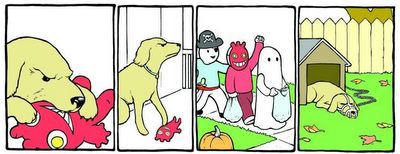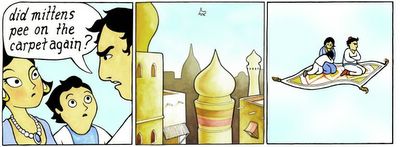A Comic Genius Among Us
I would like to signal the emergence of a talented comic strip artist, Nicholas Gurewitch. Nicholas recently was a student a little over to the right of me in the State of New York, though I have yet to have the pleasure of meeting him. His self-introduction and a generous if not complete series of links to his comic strip, the curiously named "Perry Bible Fellowship," can be found at his website of the same name. I first discovered his work in the locally-distributed magazine The Beast.The test of a great comic strip must reside in two parts: one part, belly, one part, brain. The first of these is hammered on pretty soundly by the Perry Bible Fellowship. Before the belly has even come to rest, however, the brain starts to secrete some of its more delicious fluids, and if there is something like an after-taste in the frontal lobe, I must have experienced it several times upon discovering Nicholas's most recent strips. So it is that one is able to return to these strips repeatedly and, lingering on lines drawn with the strictest economy, savor, for instance, the intense expression of a hairless human figure devoid of color and shadow.
In breaking with the nearly-uniform principle of presenting only images that I myself have taken or produced in one way or another, I offer a few of Nicholas' strips below because Nicholas kindly agreed to let me reproduce them here and because merely talking about comic strips would not do them justice.
I will sample only five of the strips and leave the curious reader to visit the many links of the Perry Bible Fellowship archive.

1 "Moving Birthday" (alternately titled "April 2"): this is the first strip of the Perry Bible Fellowship that I came across. The strip dips into the ambiance of the times and, without crassness or mockery, imagines a humorous and authentically human response to penury as experienced by a small family unit. The father's action is a step cleverer than those of Roberto Benigni's character in the film "Life Is Beautiful," for it is laced with the ambiguity of a subterfuge that is both survivalist in its impulse and turned against the child it is meant to placate or assuage. That Nicholas was able to convey all of this in four meager frames is what made me seek out more of his strips.

2 "Book World" presents a wry recollection of happy-happy education propaganda the sort to which children the world over are surely exposed. Who can view this strip and not chuckle nostalgically at all the well-meant but insipid institutional morale-boosting of one's early days in school? As often is the case in the Perry Bible Fellowship, the gleeful look emanating from the beady black eyes of the child in frame #2 portends an ironic reversal.
Out-on-a-wing speculation: possibly some of the Christian purists who huffed and puffed over the black magic contained within the Harry Potter series could, with a little touching-up of the book title, turn "Book World" to their own propagandistic effect?

3 "Lord Gloom" : The Perry Bible Fellowship, a name whose sense somewhat escapes me, is at least at times anachronistic, since the comic strip is peopled by what appear to be figures of Nicholas's own mythological invention that nonetheless owe their features and dress to various realms of archeological or pre-modern history, including dinosaurs and armored knights, but that Nicholas endows with what I believe are original character traits. "Lord Gloom" exemplifies this no less than "Colonel Sweeto." (For the latter, see the archive.) It is surely one of the outstanding features of The Perry Bible Fellowship that its characters are so diverse, even to the point where they are depicted by means of a completely different illustration style than are other members of the Fellowship. Similarly, one never knows into which period of time the Fellowship will next travel. Moreover, the printing type or font is not mechanically uniform from one strip to another but varies to reflect emotional or historical elements in keeping with the figures presented. These ever-changing aspects open up a vast range of perspectives and attitudes that, we can only hope, the Fellowship has just begun to explore. In this, the comic strip is a true "fellowship" of moods and comic turns of mind and is thus superior to the typical comic strip that is limited by a set of characters defined narrowly from the out-set (say, "geeky white-trash suburban family from the 1950s") or, worse, by a single, rigidly conceived character ("indifferently arrogant cat").
All that being said, Nicholas works illustrative economy to such an effect that, at times, he simply dispenses with words and lets the images speak for themselves, as in the following strip:

4 "Chew Boy" : This is one strip among several whose title is indispensable (although, strangely, the strip titles do not appear in the paper in which I read The Perry Bible Fellowship). Here, as elsewhere, Nicholas chooses his title with economy and in a way that plays up possible ambiguities. "Chew Boy" : Is this the once frequent command of a dog-owning parent who at holiday time lacked foresight in crafting a son's or daughter's costume? The corporate name of a dog toy? Or, perhaps, a curt evocation of the hapless costume-wearer's fate?
This eloquently silent strip puts to shame whole reams of conventional Sunday comics. Its joke is all in the viewer's mind. Or, rather, Nicholas has slipped it into the interstice between frame #3, where a boy waves in holiday cheer, and #4, where the dog, whose fate may well appear unjust, simmers under its muzzle. In the interstice it is less our eyes than our mind that is called to linger... and laugh.

5 "Mittens" : With apologies to cat lovers everywhere, this strip concentrates its comic energy discreetly in frame #2, whose significance, I think, may not be apparent on first viewing. (Click on the strip to view an enlargement.) As with any comic strip that hits both brain and belly, "Mittens" pulls the reader's gaze back to frame #2, where it discovers the apparently immobilized image of a cat that, one soon realizes, is in fact in a fatal free fall. From this the reader's eyes return to frame #1 to savor the eloquently traced human faces. And, with this back-n-forth waking rapid eye movement, the final frame depicting a "father sitting in judgment" only gains in comic power.
All images presented by permission of the artist, Nicholas Gurewitch.
(11086)
<< Home